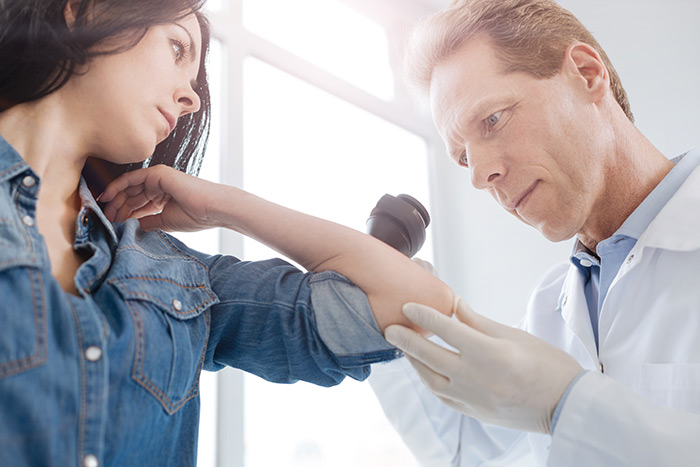Basal Cell Cancer
Basal Cell Cancer
We try to recommend the following in our practice. We try to recommend complete skin exams from head to toe every six months. We try to recommend all patients get into gowns for these exams. We try to recommend sunscreen SPF 30 or greater and avoidance of sun at peak hours between 10 to 2. Lastly we educate our patients on what signs and symptoms to watch out for in terms of skin cancer. We try to recommend that if any growth on the body, changes, grows or bleeds, that you call our office immediately for evaluation of that growth.

What is Basal Cell Cancer
Non-Melanoma Skin Cancer
Skin cancer is the most common form of cancer in the United States. More than 1 million cases are diagnosed annually. There are three major types of skin cancer: basal cell carcinoma, squamous cell carcinoma, and melanoma. The most common types of skin cancer are basal cell and squamous cell skin cancers. These cancers make up the majority of skin cancer cases. They usually form on the head, neck, face, hands, and arms, but can occur in other places as well.
What Are Basal Cells and What Do They Look Like?
Basal cell carcinoma is the most common cancer in humans. Basal cell skin cancer grows slowly. It usually arises on areas of the skin that have been in the sun. It is most common on the face. Basal cell cancer rarely spreads to other parts of the body.
Basal cell carcinoma can take several forms. It can appear as a shiny translucent or pearly nodule, a sore that continuously heals and then re-opens, a pink slightly elevated growth, reddish irritated patches of skin, or a waxy scar.
What Are Squamous Cells and What Do They Look Like?
Squamous cell skin cancer usually occurs on parts of the skin that have been exposed to the sun. However, it also may be in places that have not been in the sun. Squamous cells may also occur from actinic keratoses, which are dry, scaly lesions that may be skin-colored, reddish-brown or yellowish-black. Squamous cell cancer sometimes spreads to lymph nodes and organs inside the body.
Squamous cells usually appear as a crusted or scaly area of skin with a red inflamed base that resembles a growing tumor, non-healing ulcer, or crusted-over patch of skin.
What Is the Best Treatment?
If the tissue is cancerous the doctor considers a number of factors to determine the best treatment for skin cancer, such as the location of the cancer, its size, and whether or not the cancer has spread beyond the skin. There are three basic surgical techniques available to remove the cancerous growth: electrodesiccation and curettage, conventional surgery and Mohs’ surgery.
Electrodesiccation and curettage scrapes the cancerous skin with a curette, an instrument with a sharp, spoon-shaped end. The area then is generally treated by electrodesiccation. Electrodesiccation is an electric current from a special machine that is used to control bleeding and kill any cancer cells remaining around the edge of the wound.
Conventional surgery cuts the cancer from the skin along with some of the healthy tissue around it.
Mohs’ technique shaves off one thin layer of skin at a time until the entire tumor is removed.
There are other non-surgical techniques such as cryosurgery (freezing the tumor), laser therapy (uses a narrow beam of light to remove or destroy cancer cells), radiation therapy (uses high-energy rays to damage cancer cells and stop them from growing), or topical chemotherapy (anticancer drugs in cream or lotion form that are applied to the skin).
